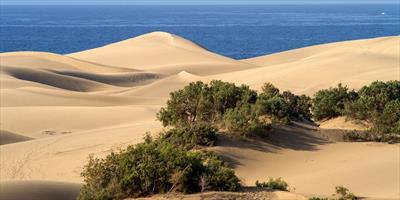Introducing Gran Canaria
Gran Canaria together with the neighbouring Tenerife forms the centre of the Canary Islands. Gran Canaria is 60 km to the east-southeast of Tenerife (you can see it), 84 km to the west of Fuerteventura, and a little over 200 km from the coast of Africa.
The coordinates of Gran Canaria are 27°58′ N 15°36′ W.
Surface and Landscape
Gran Canaria Surface Area
Though the name would suggest it, Gran Canaria is not the biggest island in the Canaries. It has a surface area of 1,560 km², which is enough for third place behind Tenerife and Fuerteventura. It has round shape (or a seashell shape to some people) with diameter of about 50 km.
Landscape and Highest Mountains
The landscape on Gran Canaria is mostly mountainous, though the peaks do not reach the heights of Mount Teide on Tenerife. The highest point on Gran Canaria is Pico de Las Nieves 1,949 metres above sea level. The second highest mountain, but better known, is Roque Nublo.
Gran Canaria Volcanoes
Gran Canaria is of volcanic origin like the other islands. Geologically it is younger than Fuerteventura or Lanzarote, but older than the western islands like La Palma or El Hierro. The last major volcanic activity is estimated 2,000 years ago. In the middle of Gran Canaria you can still see the original crater, Tejeda Caldera, which has about 20 km in diameter. It is in a more eroded stage than Caldera de Taburiente on La Palma, but still clearly recognisable.
Population
In terms of population, Gran Canaria with its 830,000 inhabitants is almost the same size as Tenerife. These two islands represent more than 80% of Canary Islands total population.
Municipalities in Gran Canaria
There are 21 municipalities in Gran Canaria. Sorted in alphabetical order they are: Agaete, Aguimes, Artenara, Arucas, Firgas, Galdar, Ingenio, Mogan, Moya, Las Palmas de Gran Canaria, San Bartolome de Tirajana, San Nicolas de Tolentino, Sta. Brigida, Sta. Lucia de Tirajana, Santa Maria de Guia, Tejeda, Telde, Teror, Valleseco, Valsequillo, and Vega de San Mateo.
If you are surprised that you have not found the popular beach resorts like Maspalomas and Playa del Ingles, or Puerto Rico on the list, note that these are parts of the municipalities of San Bartolome de Tirajana and Mogan, respectively.
Las Palmas de Gran Canaria
The city of Las Palmas is the capital of Gran Canaria and the whole Las Palmas province, which also includes the islands of Fuerteventura and Lanzarote. Las Palmas has a population of nearly 380,000 and it is the biggest city in the Canary Islands. It shares the status of Canary Islands capital with Santa Cruz de Tenerife.
Las Palmas also holds the special record of being the biggest city in the European Union which geographically lies outside Europe (Santa Cruz de Tenerife comes second).
